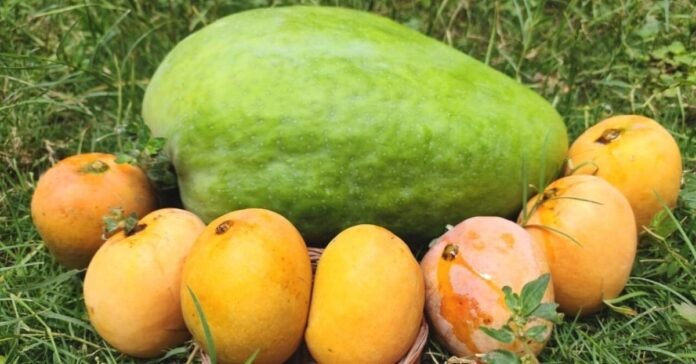
What’s summer without mangoes? As the heat intensifies, so does the country’s love for the king of fruits. While varieties like Alphonso, Banganapalli, Dasheri, Kesar, Langra, and Totapuri dominate the Indian market, a rare gem has been making waves in Madhya Pradesh—the Noorjahan mango.
Weighing between 3 to 3.5 kilograms and growing up to one foot in length, Noorjahan mangoes are a marvel of nature that have now become the talk of the town.
The Journey of Noorjahan: From Afghanistan to India
This magnificent mango, named after the Mughal queen Noor Jahan, has a regal history. It is believed to have made its way to India centuries ago from Afghanistan, passing through Gujarat before finding its ideal home in Madhya Pradesh’s Katthiwada region. The unique soil, climate, and weather conditions of this region contribute to the mango’s exceptional size, flavour, and texture.
These mango trees begin to flower in January or February, and by June, the massive golden fruits are ready for harvest.
The Farm Behind Noorjahan’s Fame
One of the most renowned farms cultivating Noorjahan mangoes is Noorjahan Mango Farms in Katthiwada, managed by Shivraj Singh Jadav. “My father started this farm back in 1965, using a single graft of this variety,” Shivraj shares.
Although Noorjahan mangoes were locally known for decades, it was only recently that they gained national and international fame, thanks to viral social media posts showcasing their enormous size. Shivraj’s father was even featured on national television between 1978 and 1981, helping the farm gain regional recognition.
Noorjahan’s Global Reach
Today, Noorjahan mangoes have gone beyond Indian borders. “A plant that my father cultivated in our backyard now has a worldwide reach,” Shivraj says proudly.
With its juicy, saffron-like flavour and delicate skin, Noorjahan has gained popularity in the global market, particularly in the US and UK, where demand for exotic and premium mangoes is high.
How to Grow Noorjahan Mangoes: A Step-by-Step Guide
Inspired by the grandeur of Noorjahan mangoes? Here’s how you can cultivate this royal variety in your own backyard:
1. Selecting the Graft
The first step is obtaining a healthy Noorjahan graft. Noorjahan Mango Farms in Katthiwada is a well-known supplier. S R Thakur, a nursery grower from Nagpur, confirms, “I procured a Noorjahan graft from Shivraj’s farm years ago to prepare saplings. They sell very well.”
2. Choosing the Right Location
Noorjahan mango trees thrive in fertile, well-drained soil. They require ample sunlight and moderate rainfall. The ideal soil should be slightly acidic to neutral to support optimal growth.
3. Planting the Tree
Once you have the graft, plant it in prepared soil, ensuring adequate spacing. Noorjahan mango trees can grow up to 50 feet high, so they need room to spread their roots and branches.
4. Watering and Maintenance
During flowering and fruit-bearing seasons, Noorjahan mango trees need regular but controlled watering. Overwatering should be avoided to prevent root rot. Prune the tree periodically to remove dead or damaged branches and encourage new growth.
5. Pruning for Better Yield
Since these mango trees can grow tall, regular pruning is essential. Removing excess branches improves air circulation and sunlight penetration, leading to better fruit production.
6. Harvesting the Royal Fruit
After five years of care and patience, the Noorjahan mango tree will start producing fruit. The mangoes mature around June, and due to their enormous size, they must be carefully handpicked to prevent bruising.
A Regal Delight for Mango Lovers
Even as mango lovers across the world crave Alphonso and Kesar, Noorjahan stands out as an extraordinary variety, both in size and flavour. Whether you’re a farmer looking to cultivate this rare gem or a fruit lover eager to taste its saffron-like richness, Noorjahan mangoes truly embody the grandeur of their royal namesake.

